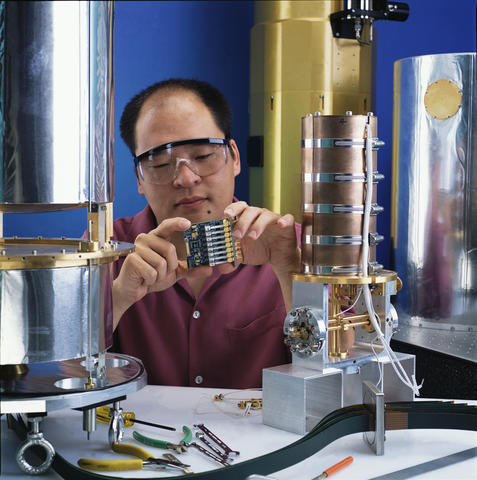
©Geoffrey Wheeler
Physicist Sae Woo Nam, who pioneered techniques for detecting individual photons - the tiniest quantities of light - passed away on Jan. 21, 2024, after a 14-month battle with brain cancer. He was 53 years old.
During his 25-year career at the National Institute of Standards and Technology (NIST), Sae Woo performed groundbreaking work on single-photon detectors, which are now used for everything from building photon-based quantum computers and testing the deepest foundations of quantum physics to searching for the invisible "dark matter" in the universe.
Detecting, manipulating and measuring photons is extremely challenging. Photon detectors made with semiconductors fall far short of sensing all the photons that strike them. Using superconducting detectors operating at ultracold temperatures, Sae Woo and his NIST colleagues developed the world's most efficient single-photon detector in 2010, detecting 99% of all photons that struck it. These single-photon detectors are now used all over the world for an array of science and technology applications.
"Sae Woo's work has had a profound impact on his field that will forever be part of his legacy," said Under Secretary of Commerce for Standards and Technology and NIST Director Laurie E. Locascio. "He has also had a profound impact on NIST, and with his passing, we have lost a brilliant scientist, a thoughtful mentor and a great friend."
Sae Woo spent his formative years growing up in Dayton, Ohio, with his mother, father and sister. His father and uncles provided early encouragement and opportunities in physics research.
Sae Woo earned a bachelor's degree in physics and a master's in electrical engineering from the Massachusetts Institute of Technology in 1991. He completed his Ph.D. at Stanford University under Professor Blas Cabrera, developing superconducting detectors for dark matter searches. He then joined NIST as a National Research Council postdoc in 1999 to continue his development of the detectors, known as "superconducting transition-edge sensors." Following his postdoc, Sae Woo became a permanent staff member at NIST, where he led numerous scientific projects, served as a program analyst in the NIST director's office, and most recently led the Faint Photonics Group in the Applied Physics Division. He became a NIST Fellow in 2013, an honor that recognizes those federal employees who have upheld NIST's values of perseverance, integrity, inclusivity and excellence, and have demonstrated leadership in science and technology both within NIST and beyond.
Sae Woo's scientific work made a major impact, evidenced by the widespread applications in which his highly efficient single-photon detectors are employed. In addition to being building blocks for photon-based quantum computers, single-photon detectors are used in "neuromorphic" computing, in which computers mimic the human brain. These devices are also deployed in various techniques for detecting dark matter, for handling the "quantum keys" that are used for secure communications, and in measuring optical power. Single-photon detectors have also enabled the most stringent tests of Bell's Inequality Theorem, which showed definitively that the outcomes of quantum mechanics experiments were not governed by the "hidden variables" that Albert Einstein predicted. The devices also paved the way for the quantum networks that are now being built to enable quantum computers to connect, communicate and combine their computing power over large distances.
As a scientist, Sae Woo was known for being a creative tour de force with a strong scientific and moral compass. His humility and determination meant he was willing to do any job to advance science.
Over the course of his scientific career Sae Woo received numerous awards and honors. He was awarded the Gold Medal in 2011, the highest honor from the Department of Commerce. In 2008, Sae Woo was honored with the NIST Jacob Rabinow Applied Research Award for his record-breaking efficient photon detectors, and he received the Arthur S. Flemming Award for Applied Science, Engineering and Mathematics. He earned the Presidential Rank Award in 2017 for his advances in quantum information. In 2020 Sae Woo became an APS Fellow. He was also named an Optica Fellow in 2011 and an IEEE Fellow in 2022. The work of Sae Woo and colleagues in testing Bell's Inequality Theorem was also cited in the 2022 Nobel Prize for Physics.
"In addition to his brilliance, Sae Woo was both fearless and humble. He was passionate to improve both the world around him and NIST," said his wife and colleague, NIST chemist Kimberly Briggman. "He valued the principles of diversity and inclusion and challenged the people around him to do their absolute best. Perhaps a little-known fact about Sae Woo is that despite all of his accomplishments and awards, he was always embarrassed to take credit. Instead, he attributed any successes of his programs to his team of colleagues and coworkers."
Outside of his passion for science, Sae Woo was an avid athlete, taking up rock climbing, mountain biking, ice hockey and snowboarding. He was also a foodie, getting friends and co-workers together to experiment with new recipes and enjoy meals together.
"Sae Woo's passing leaves a huge hole at NIST and beyond. He fought fiercely for his principles, and for the people he worked with," said Kristan Corwin, chief of NIST's Applied Physics Division. "I was also deeply touched by his gratitude to his family and friends, which he eloquently expressed during a plenary talk at the 2023 Optica Quantum 2.0 Conference before his colleagues worldwide. He is deeply missed."






